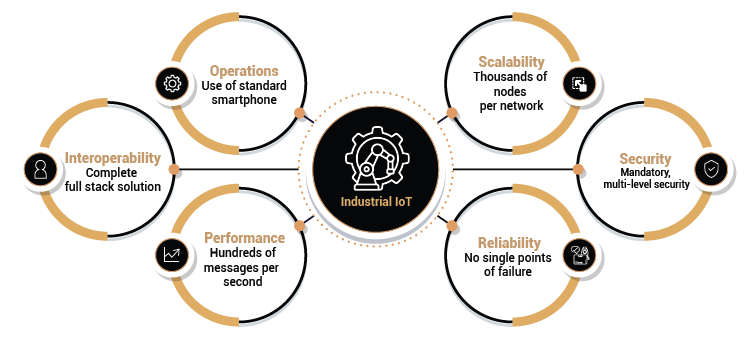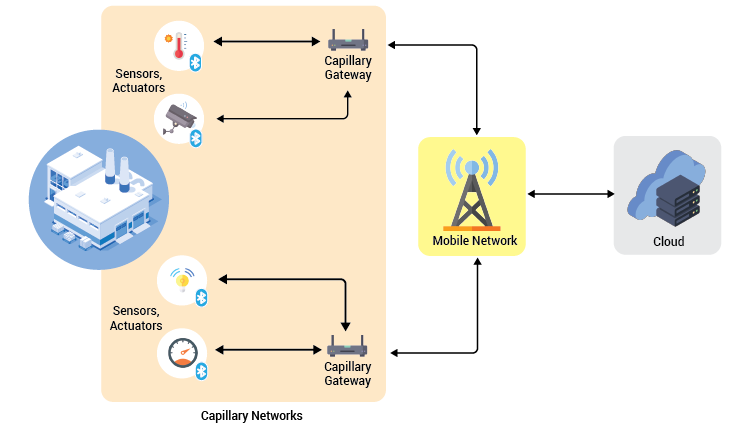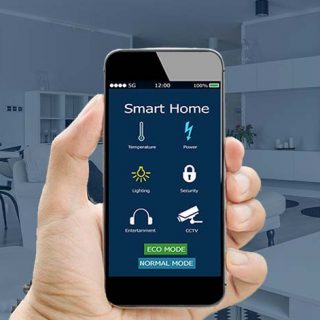Bluetooth, a well-known wireless technology has continued expanding its capabilities across the world. The adoption and device production of Bluetooth technology has dramatically increased every year. The advancements in Bluetooth technology have continued its positioning for new environments, including the commercial and industrial use cases. The technology enables low-power and low-cost sensors, precise positioning, wireless connectivity, and power to compute and analyze the collected data (big data analytics).
In Industrial IoT (IIoT) 4.0, efficiency and productivity are important, and Bluetooth® mesh technology is leading this market to provide the required level of standard. According to the research, there will be around 200 million annual shipments of bluetooth® devices to be used in Industrial IoT by 2025.
BLE Mesh Technology for Industry 4.0
Bluetooth Special Interest Group (SIG) has standardized Bluetooth mesh networks, designed from scratch to meet the industry standards where performance, reliability, and security are of utmost importance. This technology is based on the Bluetooth LE specification and is compatible with existing Bluetooth LE devices. However, in comparison with the other low power wireless networking technology, Bluetooth mesh technology is a complete full-stack solution that includes everything starting from the low-level physical radio layer to the high-level application layer.
What makes BLE Mesh Ideal for Industrial Applications?
There are many reasons which make BLE mesh suitable for Industrial applications in place of other wireless technologies. In any industrial area, there are multiple sensory networks which are either capturing some information or working as per the configured parameter which changes as per the need. Handling such a complex network and lots of configurations is a challenge for any wireless technology. BLE mesh network is best suited for such application as it revolutionizes mesh communication in the following ways,
- Decentralized Control: As intelligence is distributed between all end devices, therefore the Bluetooth mesh does not require any centralized control. For example, in a lighting application, the bulbs can directly communicate with each other by centralized controllers using BLE mesh network technology. This architecture is simple, scalable, archives higher performance, reliability and lowers the costs.
- Publish/subscribe Addressing: With the addressing method, multicast traffic is manageable and reduces heavy traffic over the network. Let’s understand this by an example, in a lighting solution conference room, lights need to be turned ON. But rather than sending a unicast packet to each light with BLE mesh, the pub/subscribe addressing technique addresses all devices that have subscribed to the conference room group and receive the message of turn ON itself, which improves the performance of lowering network traffic
- Managed Flood Relay: When end nodes are not in direct range of each other they have to pass the message by using some relay nodes. The legacy method of forwarding these packets via relay nodes adds up overhead on the controller and may lead to issues. To overcome this, BLE mesh has adopted managed flood relay mechanism
BLE mesh enables the use cases with large-scale device networks, ideally suited for monitoring/controlling a specific area where a mesh network consists of a number of devices which needs to be communicated between each other autonomously with added features of scalability, security, reliability, performance and so on.

Publish-subscribe Model for Communication in BLE Mesh
- Bluetooth mesh network technology supports up to 32767 devices in a network with a maximum network depth of 126 hops. The BLE mesh network nodes are configured to work as a publish-subscribe model, where information among nodes is transferred through small data packets. Therefore, the sensor nodes use the data packets to publish information on the network and at the same time, other nodes can subscribe to this data. To spread this message across the network, the originating node broadcasts a message using advertisements and other nodes in the network receive the message and forward it to other nodes, which in turn extends the range of the mesh network beyond the capability of an individual Bluetooth link.
How BLE Mesh Features are Suitable for Industrial Applications
The features provided by BLE mesh technology have opened new paths for several Industrial IoT applications. Such large industrial sensor networks are used at logistics hubs, warehouses, public places, construction sites, etc. Bluetooth® location-based services and smart wearables are also wide use cases in Industrial real-time sensor controlling and monitoring.
As shown in the below illustration, the BLE mesh network utilizes Bluetooth® short-range radio in sensor modules. These sensor modules could be either a temperature sensor, thermostat, light bulb or camera module. There are limitless possibilities for these smart Bluetooth® modules which can be integrated into an existing network and are used to communicate with gateways. Nowadays almost all smartphones support Bluetooth, therefore this makes it an obvious tool for sensor and network configuration with mobile networks to the internet.

However, the latest generation of smartphones that support Bluetooth technology can be used as mobile gateways between the Internet and Industrial devices. So, many industries can replace it with Bluetooth LE for this use case, to bring down device cost and power consumption.
Large Industrial Use Cases with BLE Mesh Network
There are many use cases which start from smart lighting to smart building covering: Asset tracking, beacon management, occupancy control, predictive maintenance, HVAC systems, emergency lighting, building automation, etc. With an existing mesh network, one can integrate an N number of applications on the same network. Let’s understand the use cases in detail:
- Device Networks: Device network application comes alive with scalable applications in commercial buildings which are equipped with tons of electronics devices and are being managed manually by the administration. Bluetooth® device network solutions can connect thousands of such devices within a network reliably and securely. Below are some of the use cases,
- Control Systems: To control the electronics equipment such as lighting and HVAC systems for their power status, configuring the thermostat, getting the information from the electronics sensor and adapting the other sensors according to the need is a very complex task. And to achieve this mesh network setup could allow controlling the lighting and HVAC in industrial buildings with an ace which enables efficient control and saves power during inactivity periods for specific zones
- Monitoring Systems: There are applications in automated irrigation systems to grow plants for high yields. Indoor planting requires the environment with the right amount of light source, temperature/humidity, soil moisture and automated irrigation, all these sensory networks can be leveraged with a Bluetooth mesh to autonomously operate without any human interventions
- Location Services: To address the skyrocketing demand for accurate indoor location services, Bluetooth mesh technology is a smart choice as location info and device positioning can be tracked accurately. A Bluetooth mesh network enables one node to have accurate information on the location of another node. It also delivers flexibility and tons of configurable possibilities, allowing the building owners to scale indoor positioning solutions to match the varying and changing needs of the building. The Bluetooth location service is accomplished with the use of connected mobile applications.
- “The mobile receives Bluetooth signals from beacons installed on specific objects inside any vicinity. These beacons when coming into contact with any user it sends either location data, directions to desired places, or any other useful information targeted to some application use case via Bluetooth advertisements and push notifications.”
- Let’s understand the location service use cases:
- Asset Tracking: Bluetooth mesh network technology is fueling rapid expansion in the real-time locating system (RTLS) solution which is used for tracking different objects/people. With this information, it is easy to monitor the location of valuable assets. Here, the asset tracking can be either for locating important material from the factory, medical equipment, patients in the hospital and so on
- Indoor Navigation: It is seen that visitors have to struggle to get the navigation for specific spots at public places like malls, museums, airports and train stations. Bluetooth® indoor positioning systems (IPS) provide an ace of accessibility in these situations and come to the rescue. With these sensors, it becomes easier for visitors to navigate through any of these complex facilities
- Digital Key: Smartphones are becoming a usual and integral part of everyday life. Bluetooth mesh technology enables smartphones to be used as a digital key for access control applications. Users can unlock doors and restricted spaces as they approach in front of their car or home doors or office buildings and many more such scenarios. This is a very convenient and secure way to have a digital key to unlock things in a daily life
Future of Industrial IoT with BLE Mesh
The latest BLE mesh standard SIG released has boosted the operational range, increased speeds, and opened up new doors for mesh networking or many-to-many point use cases. The major advantage is that Bluetooth devices can run for years on a coin-cell battery, and that is because of the radio power optimizations. All these features coupled with the reliable security and scalability of its wireless communication make the BLE mesh network a remarkably ideal solution for industrial organizations. It’s going to revolutionize the Industrial IoT (IIoT) market and kickstart adoption in the wide market. Bluetooth will offer a reliable, scalable and low-cost solution for augmenting smart buildings and factories of the future that will rely on this tech to grow and move forward.
About VOLANSYS
VOLANSYS has proven experience in wireless technology and protocol that helps the client in developing a next-generation solution. Being a one-stop solution provider, we excel at all stages starting from the conceptualization to design, development and testing to meet the ever-expanding needs of our customers.
To know more about our experience and expertise, you can check out our success stories. For more details, feel free to contact us.

About the Author: Shalin Doshi
Shalin Doshi is an Embedded software engineer associated with VOLANSYS Technology for 3 years. He has 8 years of experience in the Embedded Systems domain with various wireless technologies, as an application software architect, and industrial automation solution provider.









